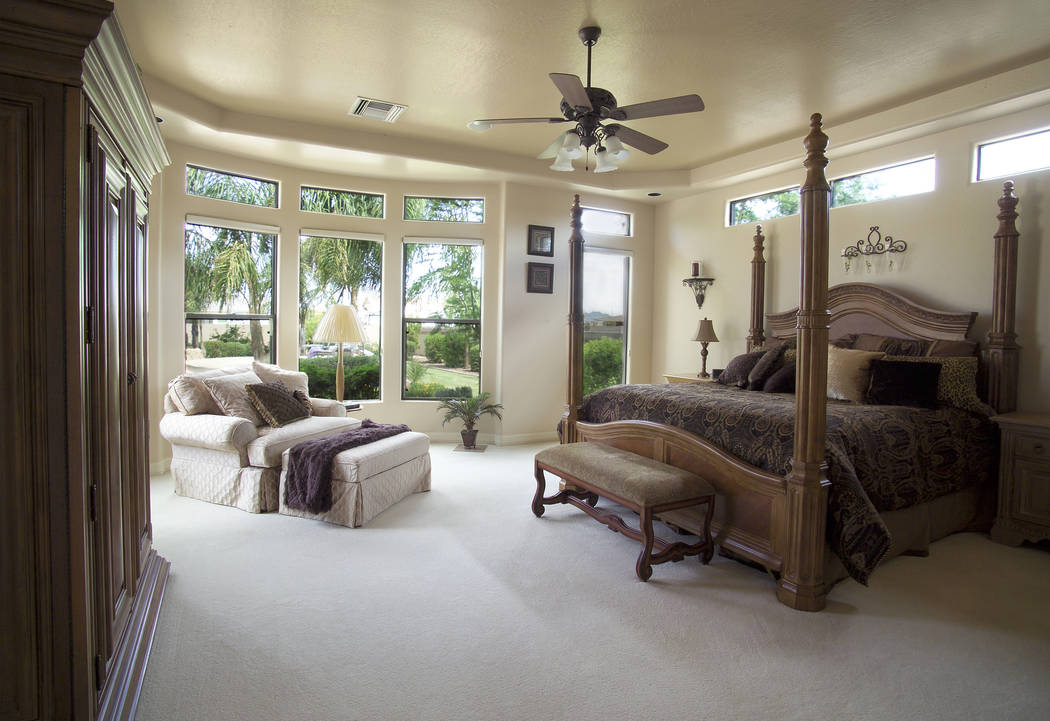Ceiling fans can help cool rooms during summer
DEAR Gail: We recently moved here from North Dakota, so we are new to the Las Vegas summer weather. I know that for most people it’s still considered cool, but for us, it’s already pretty warm. The home we purchased doesn’t have ceiling fans, so we’d like to get some installed before the true heat of the summer gets here. Could you share some things we need to consider before buying? — Marjorie
Dear Marjorie: Yes, the summers here can be brutal, especially for first-timers. I still remember my first summer here 38 years ago. I had no idea how hot my car door handle would get.
You’d hear this a lot: “But it’s a dry heat.” Well, 110 degrees is still 110 degrees.
I grew up in New York, and, yes, I hated the 90 degrees with 90 percent humidity. I’d still take our heat over the humidity. OK, now onto some answers for you.
1) What size should my ceiling fan be?
Choosing the right size ceiling fan for any room is important. Otherwise, it won’t properly cool your room. Knowing your room’s square footage will help you determine the proper size. A fan that’s too small for a room might not offer enough air, and one that’s too large could create excessive air movement.
You’ll also want to consider the room’s shape, number of windows, furniture placement and how cool you want it to be. Here are the general guidelines from the American Lighting Association.
Rooms up to 75 square feet should have a 29- to 36-inch fan. Medium sized rooms up to 144 square feet should have 36- to 42-inch fans. For rooms up to 225 square feet. you’d want a fan that is 50 to 54 inches.
For larger rooms, look for at least 60 inches, or consider using two fans. In addition to choosing the proper fan size, make sure to have 18 to 24 inches of clearance on all sides of the fan.
The amount of airflow a ceiling fan can produce per minute is most commonly measured in cubic feet per minute. You’ll want to look at the CFM airflow rating, or flow rate. It’s the most effective way to measure the efficiency of a ceiling fan.
2) What size downrod should I use?
The standard downrod length is 3 to 6 inches, but longer lengths can be purchased. In general, you want to mount the fan 8 to 9 feet off the floor.
National building codes require the fan blades of any ceiling fan to be at least 7 feet from the floor. The closest any flush-mount fan blades can be to the ceiling is 6 inches, so you cannot install any ceiling fan in a room where the ceiling is lower than 7½ feet without violating building codes.
If you have a ceiling less than 8 feet, consider a hugger or low profile that mounts directly on the ceiling. Hugger ceiling fans, also known as flush mount or low-profile ceiling fans, offer a solution because they are installed flush against the ceiling without the use of a downrod, which allows the fan to hang at least 7 feet above the floor.
For ceilings over 15 feet, look for a fan that is specifically designed for that height. Manufacturers do make more powerful and sturdy fans for tall ceilings.
A method commonly used to find the right downrod length is the ceiling height minus the height of the ceiling fan, minus the desired hanging height (usually 8 feet). For example, if your ceiling is 10 feet in height and your ceiling fan is 12 inches in height, you will need a 1-foot downrod to mount the ceiling fan 8 feet above the floor. You can also find downrod charts online.
The more space between the ceiling and the blades, the better the airflow and circulation, so aim for at least 12 inches.
3) Do I have to match the exact finish on the fan to my room?
Ceiling fans can complement your decor, but the finishes do not have to match. Long gone is matchy-matchy decor. But the style, as well as the finish on the housing and blades, should coordinate with your room’s decor.
There are amazing fan designs out now, so I feel it should make a statement in rooms, especially in a larger room. Now, in smaller rooms, you don’t want it to take over, but it should still add style. If you want it to disappear, select one that is the color of the ceiling.
When looking at the finish, most fans come with reversible blades, so you get two options. If you can’t find the color you’re looking for, keep in mind they can be painted.
4) What kind of light fixture should I use, and do I need one?
You don’t have to have a light kit on your fan, but I feel we can never have enough light. The light kit is used more as general lighting versus a specific function, except when over a table or work area.
Personally, I like the bowl-style light, since I don’t like to see the bulbs. A simple bowl light kit can be used for any style decor, whereas you do have to be selective with glass shades, as most have a more distinctive style.
If you have a high ceiling, look for a fan that also has an uplight. It adds a nice accent effect.
5) What direction should my fan spin?
If you want to cool down the room, the fan needs to run in a counterclockwise direction. This forces the air down, giving you a cooler feeling — what is called “the wind chill effect,” which can actually make you feel 8 degrees cooler. The faster the speed, the cooler you’ll feel.
And, yes, you can use your ceiling fans in the winter, as the reverse direction will pull cool air up to the ceiling, mix with your warmer air and distribute it back down into the room. Will it heat up your room? Probably not, but it will take the chill out.
Oh, and one last thing, which I know seems like common sense, but I have encountered it many times. If you have can lights, make sure your blades don’t extend out beyond the lights. Otherwise you’ll create a strobe light effect, which is only nice if you plan on dancing in the room.
Gail Mayhugh, owner of GMJ Interiors, is a professional interior designer and author of a book on the subject. Questions may be sent by email to GMJinteriors@gmail.com. Or mail to 7380 S. Eastern Ave., No. 124-272, Las Vegas, NV 89123. Her web address is www.GMJinteriors.com.




























